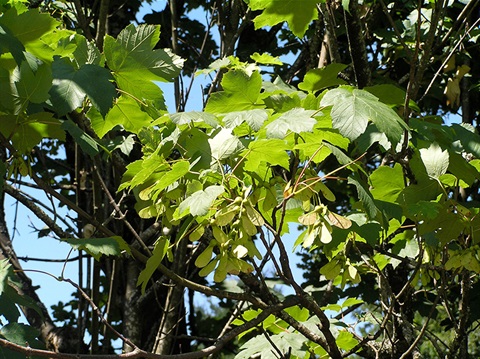Sycamore Maple

Acer pseudoplatanus
Origin: Central & Southern Europe
Size: 12 to 30m H
Fruit: December to May
Flowers: September to November
Removal time: October to March
What it does
Invades damp and wet forest areas, stream sides and gardens. Very hardy and tolerant to extreme conditions. Takes over and displaces indigenous middle storey and upper story species.
What it looks like
Tall, fast-growing, long-lived deciduous tree. It is strongly branched and has a wide, domed canopy. Bark is grey, smooth on young plants, becoming scaly and reddish on maturity.
It has dark green maple-shaped leaves that look similar to but smaller than plane trees. Leaves are 3-5-lobed and can be light green or purple underneath. Flowers are small, not easily seen and yellowish. Produces wing-shaped seeds in summer that travel in the wind similar to a propeller.
How it spreads
- Seeds prolifically with each tree producing up to 10,000 seeds per year.
- Wind, water, mulch and soil easily carry the seed.
- Will germinate from prunings dumped as garden waste.
- It is sold at some markets, fetes and nurseries. Buyer beware!
How to remove it
To save you time and energy the most effective removal treatment time for Sycamore is early Autumn, just before leaves change colour.
Remove by hand
Hand remove smaller plants in moist soils. The roots can be quite deep so be sure to remove as much of the root system as possible.
Cut and paint
For larger seedlings or smaller trees, cleanly cut as close to the ground as possible and immediately paint with an undiluted glyphosate-based product.
Drill and fill
Drill shallow holes in the trunk as close to the root zone as possible, about 2-3cm deep and 5 to 6cm apart. Fill each hole immediately with an undiluted glyphosate product.
Indigenous alternatives to plant
There are many impressive trees that are indigenous to the Shire of Yarra Ranges that would make great substitutes for the Sycamore Maple. Some alternatives include:
How to dispose of weeds
By disposing of environmental weeds correctly you can prevent re-infestation on your property and elsewhere.
- Landfill (Weed Wipeout Tip vouchers available for some species).
- Green waste bin ensures that weeds are not able to spread.
- Woody weed stems can be bundled for green collection twice per annum.
- Composting (excluding seed heads or species with vegetative reproduction, e.g. Wandering Trad).
- Burning in accordance with Council and the Country Fire Authority (CFA) prescribed burning periods and regulations.
- Recovery and transfer stations available for weed tipping are Healesville, Wesburn, Coldstream, Lysterfield and Montrose.
Using Chemicals
Non chemical treatments is often the most effective and safe option especially on smaller scale infestations.
Where chemical use is undertaken:
- Always follow the manufacturer’s guidelines when using chemicals.
- Wear protective clothing and eyewear
- On purchasing your herbicide, always ask for a Materials Safety Data Sheet (MSDS) or refer to the manufacturer’s website for specific safety guidelines and information.
- Some herbicides will kill other plants and not just the target species.
- Near waterways herbicides can be very poisonous to aquatic life.
- Use chemicals sparingly and be sure that you are using the right chemical and application technique.
- Ensure the weather conditions are suitable (e.g. minimal wind and no rain expected)
- Apply herbicides at the correct time during the plant’s growth cycle so you get the best results.